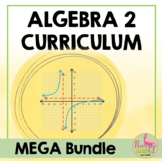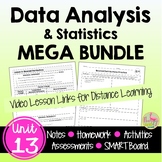Binomial Distributions (Algebra 2 - Unit 13)
- Zip
- Google Apps™

Also included in
- ALGEBRA 2 CURRICULUM MEGA BUNDLE What does the curriculum include?This resource is designed for students enrolled in ALGEBRA 2 HONORS. You will find more than 1900+ pages of instructional content (warm-ups, Guided Notes and Foldables, Google Slides, SMART Board slides, video lessons, homework, dailPrice $535.00Original Price $675.44Save $140.44
- This is a MEGA Bundle of GUIDED NOTES WITH VIDEO LESSONS for your distance learning needs, homework, daily warm-up, content quizzes, mid-unit and end-unit assessments, review assignments, and cooperative activities for Algebra 2 Honors UNIT 13: DATA ANALYSIS & STATISTICS. #distancelearningtpt⭐GuPrice $41.60Original Price $52.00Save $10.40
Description
Binomial Distributions Algebra 2 Lesson:
Your Pre-AP Algebra 2 Honors students will calculate measures of central tendency, draw, analyze, and interpret box-and-whisker plots and find outliers using binomial distributions in this Unit 13 lesson. #distancelearningtpt
What is included in this resource?
⭐ Guided Student Notes
⭐ Google Slides®
⭐ Fully-editable SMART Board® Slides
⭐ Homework/Practice assignment
⭐ Lesson Warm-Up (or exit ticket)
⭐ Daily Content Quiz (homework check)
⭐ Video Lesson Link for Distance Learning - Flipped Classroom models
⭐ Full solution set
Students will be able to:
★ Use the Binomial Theorem to expand binomials
★ Determine binomial probabilities
★ Use binomial distributions to determine probabilities
The unit includes the following topics:
1) Measures of Central Tendency
4) Binomial Distributions
6) Confidence Intervals & Hypothesis Testing
You may also be interested in:
Data Analysis Activities & Assessments
Data Analysis Stations Activity
*************************************************************************************************************
⭐For updates about sales and new products, please follow my store: My TpT Store
You can also
⭐Subscribe to my newsletter for freebies and teaching tips
⭐Follow me on Instagram
⭐Check out my Facebook page
⭐Follow me on Pinterest
I value your feedback. Please rate this product. If you have any issues or questions about this product, please feel free to ask a question in my store or write to me at jean@flamingomath.com
Thanks for shopping in my store!
Jean Adams




